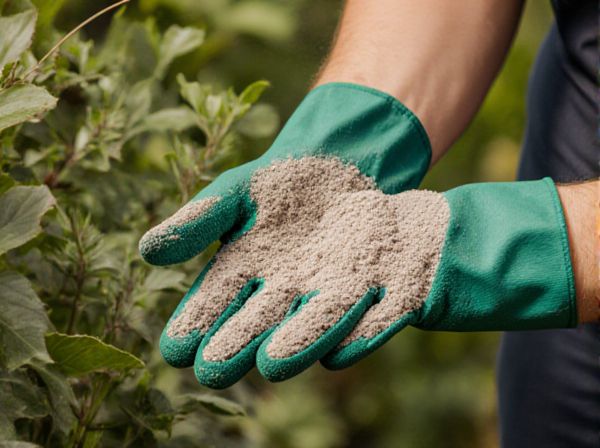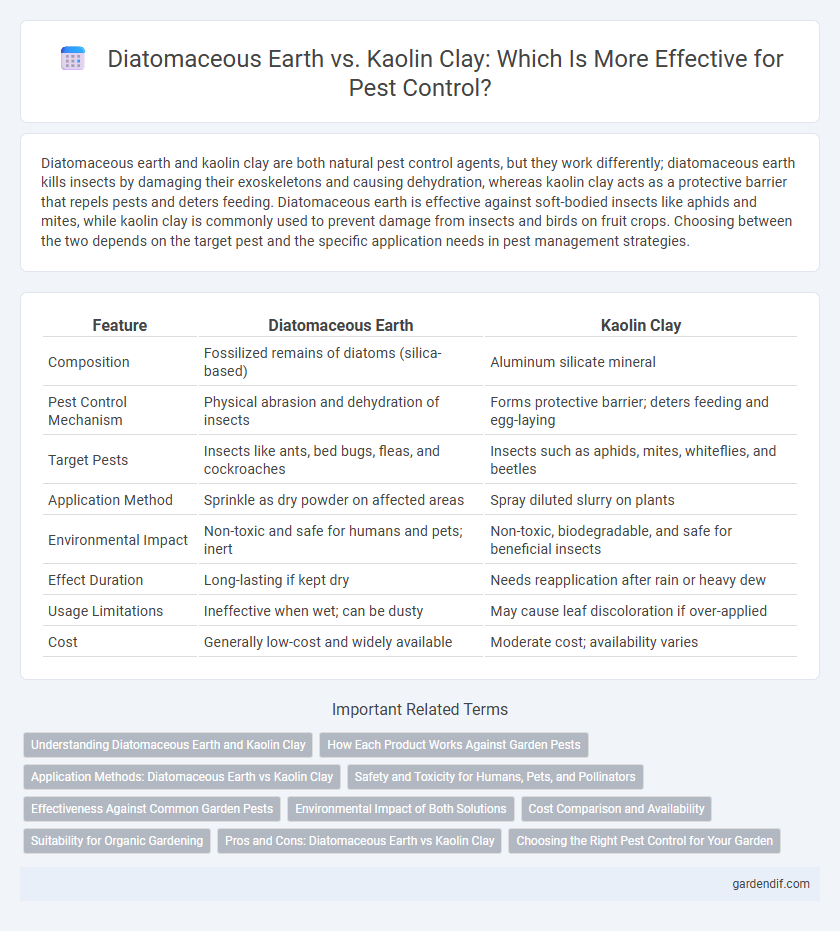
Diatomaceous earth vs Kaolin clay Illustration
Diatomaceous earth and kaolin clay are both natural pest control agents, but they work differently; diatomaceous earth kills insects by damaging their exoskeletons and causing dehydration, whereas kaolin clay acts as a protective barrier that repels pests and deters feeding. Diatomaceous earth is effective against soft-bodied insects like aphids and mites, while kaolin clay is commonly used to prevent damage from insects and birds on fruit crops. Choosing between the two depends on the target pest and the specific application needs in pest management strategies.
Table of Comparison
| Feature | Diatomaceous Earth | Kaolin Clay |
|---|---|---|
| Composition | Fossilized remains of diatoms (silica-based) | Aluminum silicate mineral |
| Pest Control Mechanism | Physical abrasion and dehydration of insects | Forms protective barrier; deters feeding and egg-laying |
| Target Pests | Insects like ants, bed bugs, fleas, and cockroaches | Insects such as aphids, mites, whiteflies, and beetles |
| Application Method | Sprinkle as dry powder on affected areas | Spray diluted slurry on plants |
| Environmental Impact | Non-toxic and safe for humans and pets; inert | Non-toxic, biodegradable, and safe for beneficial insects |
| Effect Duration | Long-lasting if kept dry | Needs reapplication after rain or heavy dew |
| Usage Limitations | Ineffective when wet; can be dusty | May cause leaf discoloration if over-applied |
| Cost | Generally low-cost and widely available | Moderate cost; availability varies |
Understanding Diatomaceous Earth and Kaolin Clay
Diatomaceous earth is a natural, abrasive powder made from fossilized algae called diatoms, effective for controlling pests by damaging their exoskeletons and causing dehydration. Kaolin clay, a fine, white mineral, works as a pest deterrent by forming a protective barrier on plants, preventing insect feeding and egg-laying. Both substances are organic pest control options but differ in their mode of action: diatomaceous earth physically harms insects, while kaolin clay acts as a physical and chemical repellent.
How Each Product Works Against Garden Pests
Diatomaceous earth controls garden pests by physically damaging their exoskeletons, causing dehydration and death through its abrasive silica particles. Kaolin clay forms a protective barrier on plant surfaces, repelling insects by interfering with their feeding and egg-laying behaviors. Both substances offer natural, chemical-free pest control methods effective against a variety of common garden insects.
Application Methods: Diatomaceous Earth vs Kaolin Clay
Diatomaceous earth is applied as a dry powder directly onto plant surfaces or soil to physically damage and dehydrate pests, making it effective against crawling insects like ants and beetles. Kaolin clay is typically mixed with water to create a sprayable solution that forms a protective barrier on plant leaves and fruits, deterring insects such as aphids and whiteflies by disrupting feeding and oviposition. Both substances are non-toxic and environmentally friendly, but application frequency and technique differ significantly, with diatomaceous earth requiring dry conditions and kaolin clay needing thorough coverage and reapplication after rain.
Safety and Toxicity for Humans, Pets, and Pollinators
Diatomaceous earth is generally safe for humans and pets when used properly, with minimal toxicity but can cause respiratory irritation if inhaled in powder form. Kaolin clay is considered non-toxic and safe for pollinators, humans, and animals, often used as a natural pesticide coating that poses low risk of harm. Both substances provide environmentally friendly pest control options, but inhalation precautions with diatomaceous earth are important for health safety.
Effectiveness Against Common Garden Pests
Diatomaceous earth exhibits high effectiveness against common garden pests such as aphids, slugs, and beetles due to its abrasive physical properties that damage exoskeletons, leading to dehydration and death. Kaolin clay creates a protective barrier on plant surfaces, deterring pests like mites, whiteflies, and caterpillars by interfering with feeding and oviposition but does not kill pests directly. For comprehensive pest management, diatomaceous earth is better suited for immediate pest reduction, while kaolin clay offers ongoing protection and pest deterrence.
Environmental Impact of Both Solutions
Diatomaceous earth is a natural, silica-based substance that poses minimal environmental risks, breaking down harmlessly without introducing synthetic chemicals into ecosystems. Kaolin clay, derived from natural minerals, also has a low environmental footprint, but its mining process can cause localized soil disruption and habitat loss if not managed responsibly. Both solutions offer eco-friendly pest control alternatives, with diatomaceous earth favored for its biodegradability and minimal soil disturbance compared to kaolin clay.
Cost Comparison and Availability
Diatomaceous earth is generally more affordable and widely available in garden centers and online retailers compared to kaolin clay, which tends to be pricier due to its specialized processing and limited suppliers. The cost-effectiveness of diatomaceous earth makes it a preferred choice for large-scale pest control applications, while kaolin clay is often reserved for niche uses or organic farming with higher budgets. Availability of diatomaceous earth in bulk quantities supports its frequent use, whereas kaolin clay requires sourcing from specialty agricultural suppliers.
Suitability for Organic Gardening
Diatomaceous earth is highly effective in organic gardening due to its natural, non-toxic properties that control pests by dehydrating insects without harming beneficial soil organisms. Kaolin clay offers a protective barrier by forming a white film on plant surfaces, deterring pests and reducing sun damage, making it suitable for organic applications where chemical pesticides are avoided. Both substances comply with organic gardening standards and provide eco-friendly pest control methods tailored to different pest management needs.
Pros and Cons: Diatomaceous Earth vs Kaolin Clay
Diatomaceous earth excels as a natural pest control due to its abrasive silica particles that dehydrate insects, but it can lose effectiveness when wet and may irritate human lungs if inhaled. Kaolin clay acts by forming a protective barrier on plants, repelling pests and reducing damage, yet it requires frequent reapplication after rain and might alter plant appearance. Both substances offer eco-friendly pest management options, with diatomaceous earth favored for dry conditions and kaolin clay preferred for crop protection against insect feeding and fungal issues.
Choosing the Right Pest Control for Your Garden
Diatomaceous earth effectively controls soft-bodied pests like aphids and slugs by dehydrating them through its abrasive silica structure. Kaolin clay forms a protective barrier on plant surfaces, deterring insects such as mites and leafhoppers while minimizing plant stress during heat or drought. Selecting between diatomaceous earth and kaolin clay depends on the specific pest type and desired plant protection, with diatomaceous earth suited for physical pest elimination and kaolin clay ideal for preventive, non-toxic defense.
Diatomaceous earth vs Kaolin clay Infographic

 gardendif.com
gardendif.com